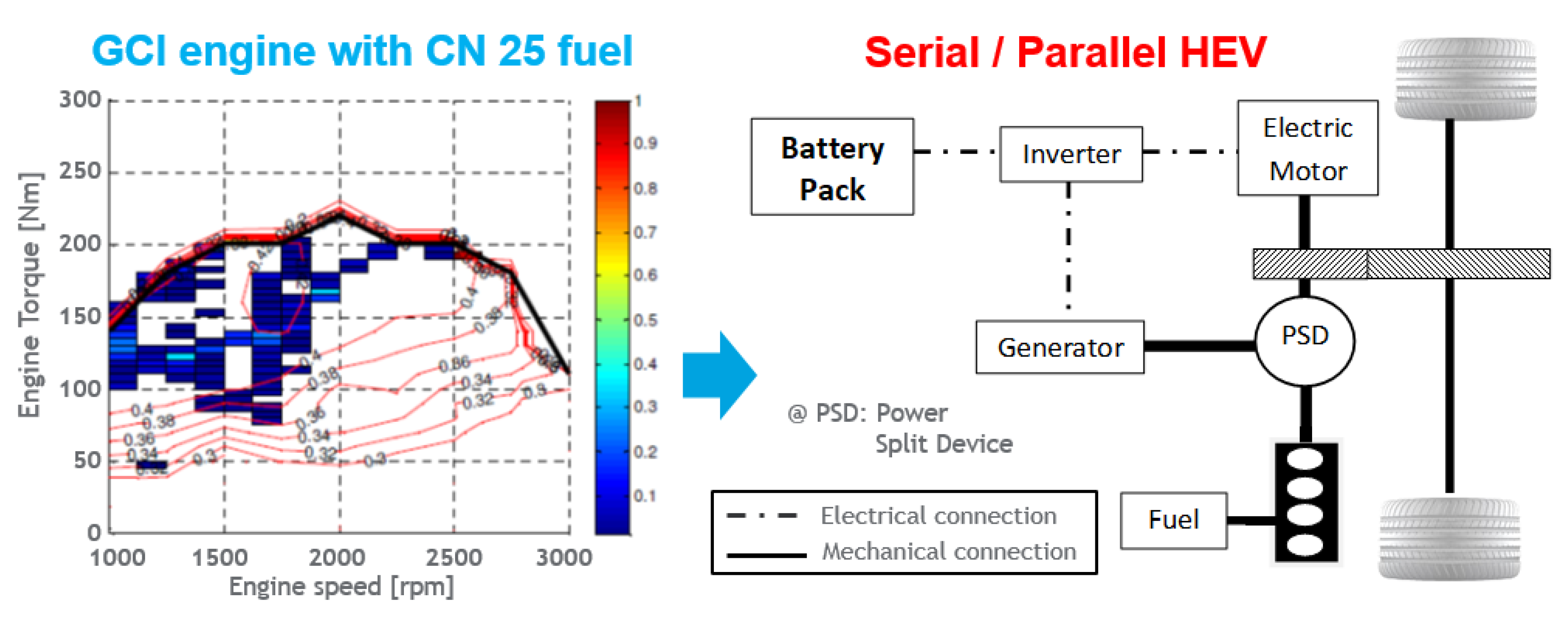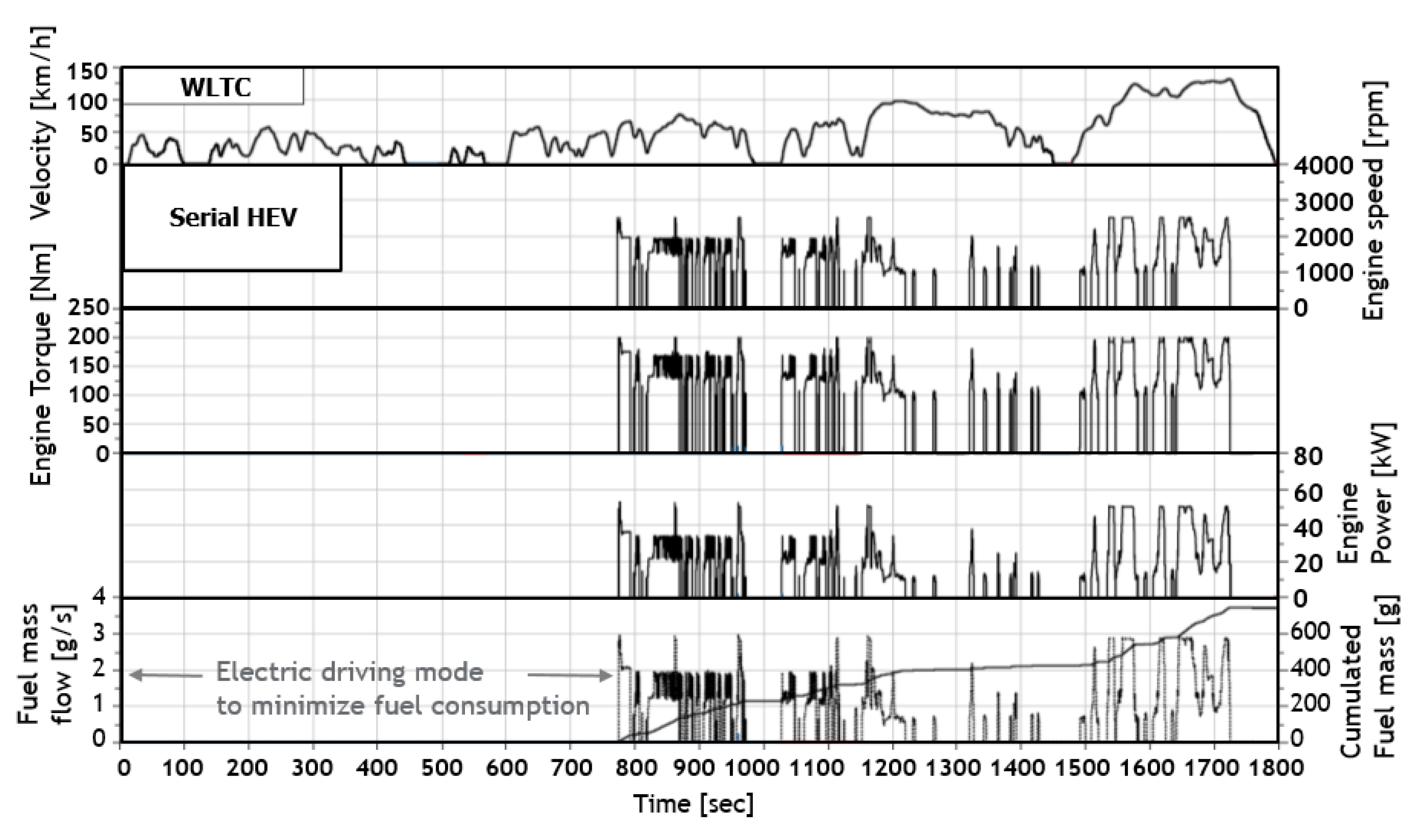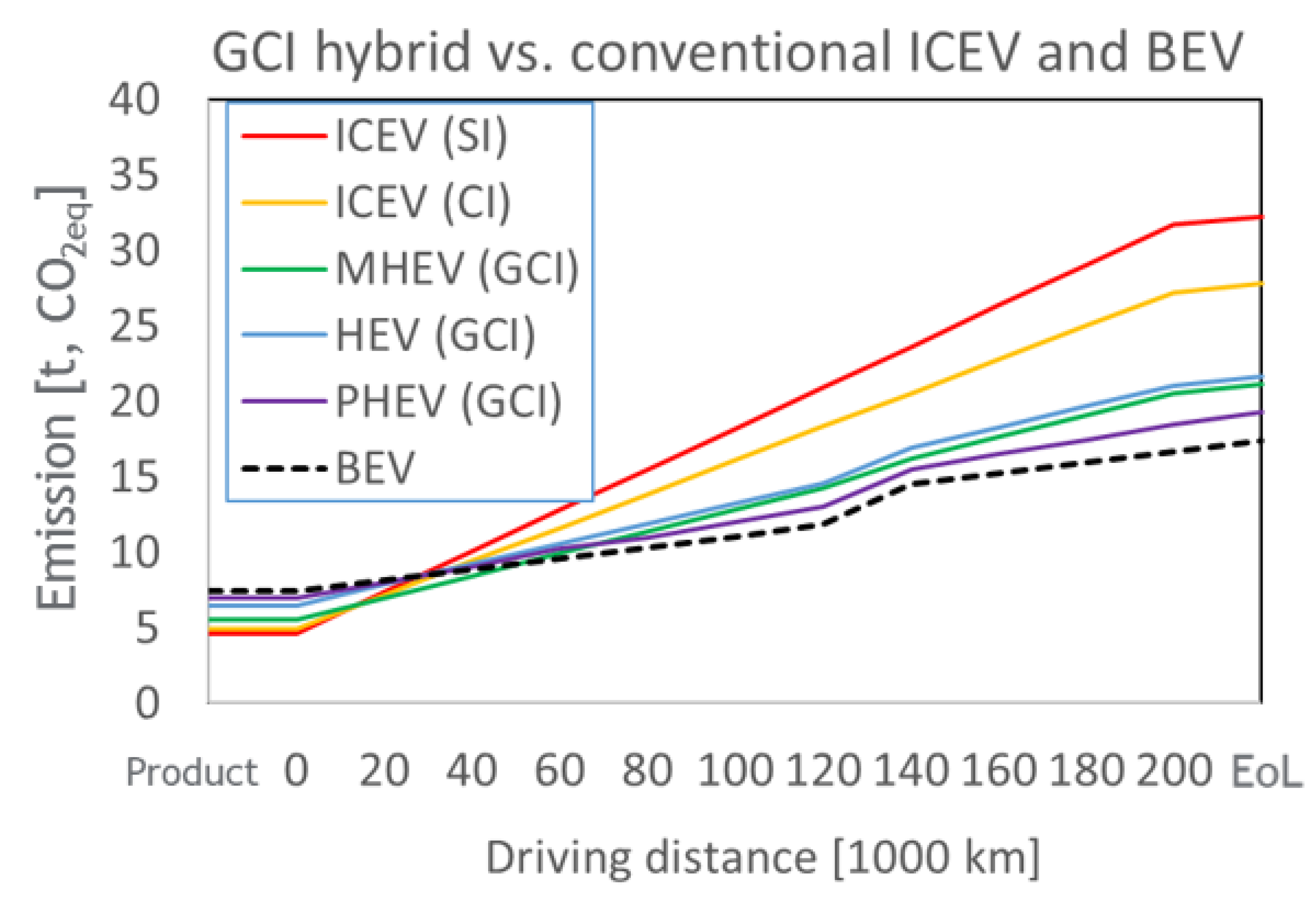A Method and System for Combining the Advantages of Gasoline Compression Ignition (GCI) Engine Technologies into Hybrid Electric Vehicles (HEVs)
Abstract
:1. Introduction
2. Materials and Methods
2.1. Experimental Setup (Fuels and Engines)
2.2. HEV Simulation Overviews
- Continuously meet the driver’s power requests based on the accelerator and brake pedal positions and the available power in the power sources;
- To minimize the global fuel consumption;
- To maintain state of charge (SOC) of the battery between the bounds of the defined SOC;
- To make sure that the battery SOC at the end of the driving cycle reaches the user’s request.
3. Results and Discussion
3.1. Understanding of GCI Combustion
3.2. HEV Simulations with GCI Engine Test Results
3.2.1. CN35 Engine with a 48 V Mild Hybrid Configuration
3.2.2. CN25 Engine with Different Hybrid Configurations (Serial, Parallel, Serial/Parallel)
3.2.3. CN15 Engine with a Plug-In Serial Hybrid Configuration
3.3. CO2 Benefits of GCI Ehicles and Life Cycle Assessments
4. Conclusions
- This study presents different HEV configurations with GCI engines. Depending on different battery size and HEV hardware scenarios, the engines operate in a high efficiency region;
- From HEV simulation, in case of non-PHEV, the GCI hybrid vehicles are able to reduce CO2 emissions (TTW) by up to 37% compared to the reference CI vehicle (up to 45% compared to modern SI engine). The CO2 benefit is up to 75% in the case of the PHEV scenario, but it requires a larger battery package and has a higher vehicle cost;
- From a life cycle assessment (LCA), vehicles running on GCI fuels and hybrid technologies, such as BEV, show potential (around 10 ton of GHG emission reduction in lifetime compared to a conventional SI engine vehicle) to provide similar effects on accumulated GHG emissions.
Funding
Institutional Review Board Statement
Informed Consent Statement
Conflicts of Interest
References
- Sims, R.; Schaeffer, R. Chapter 8: Transport IPCC WGIII Fifth Assessment Report, Report. Available online: mitigation2014.org/report/ipcc_wg3_ar5_chapter8.pdf (accessed on 19 October 2015).
- The Outlook for Energy: A View to 2040, ExxonMobil 2016. Available online: http://cdn.exxonmobil.com/~/media/global/files/outlook-for-energy/2016/2016-outlook-for-energy.pdf (accessed on 7 February 2016).
- World Energy Council. Global Transport Scenarios 2050. WEC London. 2011. Available online: http://www.worldenergy.org/wp-content/uploads/2012/09/wec_transport_scenarios_2050.pdf (accessed on 22 October 2015).
- U.S. Energy Information Administration. International Energy Outlook 2013. DOE/EIA−0484. 2013. Available online: http://www.eia.gov/forecasts/ieo/pdf/0484(2013).pdf (accessed on 22 October 2015).
- BP. Statistical Review of World Energy 2015 Workbook. Available online: http://www.bp.com/en/global/corporate/about-bp/energy-economics/statistical-review-of-world-energy.html (accessed on 26 August 2015).
- European Commission. The European Green Deal, COM (2019) 640 Final; The European commission: Brussels, Belgium, 2019. [Google Scholar]
- 2015 United Nations Climate Change Conference in Paris. In The Paris Agreement is a Legally Binding International Treaty on Climate Change; The United Nations: Paris, France, 2015.
- ICCT Report—The European Commission Regulatory Proposal for Post-2020 CO2 Targets for Cars and Vans: A Summary and Evaluation. Available online: https://theicct.org/publications/ec-proposal-post-2020-co2-targets-briefing-20180109 (accessed on 30 January 2018).
- Carlier, M. Number of vehicles in use worldwide 2006–2015; The Statistics Portal. Available online: http://www.statista.com/statistics/281134/number-of-vehicles-in-use-worldwide/ (accessed on 8 July 2016).
- Abnett, K. EU to target 30 million electric car by 2030. Available online: https://www.reuters.com/article/us-climate-change-eu-transport-idUSKBN28E2KM (accessed on 4 December 2020).
- Kalghatgi, G.T.; Hildingsson, L.; Johansson, B.; Harrison, A.J. Low NOx, low smoke operation of a diesel engine using premixed enough compression ignition—Effects of fuel autoignition quality, volatility and aromatic content. In Proceedings of the THIESEL 2010, Thermo and Fluid Dynamic Processes in Diesel Engines, Valencia, Spain, 14−17 September 2010; pp. 409–420. [Google Scholar]
- Won, H.W.; Peters, N.; Tait, N.; Kalghatgi, G.T. Sufficiently premixed compression ignition of a gasoline-like fuel using three different nozzles in a diesel engine. Proc. Inst. Mech. Eng. Part D J. Automob. Eng. 2012, 226, 698–708. [Google Scholar] [CrossRef] [Green Version]
- Won, H.W.; Pitsch, H.; Tait, N.; Kalghatgi, G.T. Some effects of gasoline and diesel mixtures on partially premixed combustion and comparison with practical fuels, gasoline and diesel, in a diesel engine. Proc. Inst. Mech. Eng. Part D J. Automob. Eng. 2012, 226, 1259–1270. [Google Scholar] [CrossRef] [Green Version]
- Akihama, K.; Kosaka, H.; Hotta, Y.; Nishikawa, K. An Investigation of High Load (Compression Ignition) Operation of the Naphtha Engine—A Combustion Strategy for Low Well-to-Wheel CO2 Emissions. SAE Int. J. Fuels Lubr. 2009, 1, 920–932. [Google Scholar] [CrossRef]
- Rose, K.; Cracknell, R.; Rickeard, D.; Ariztegui, J. Impact of Fuel Properties on Advanced Combustion Performance in a diesel Bench Engine and Demonstrator Vehicle. SAE Tech. Pap. 2010. [Google Scholar] [CrossRef] [Green Version]
- Liang, X.; Zheng, Z.; Zhang, H.; Wang, Y.; Yu, H. A review of early injection strategy in premixed combustion engines. App. Sci. 2019, 9, 3737. [Google Scholar] [CrossRef] [Green Version]
- Du, J.; Chen, X.; Liu, L.; Liu, D.; Ma, X. Mechanism of combustion noise influenced by pilot injection in PPCI diesel engiens. Appl. Sci. 2019, 9, 1875. [Google Scholar] [CrossRef] [Green Version]
- Cho, K.; Latimer, E.; Lorey, M.; Cleary, D.; Sellnau, M. Gasoline Fuels Assessment for Delphi’s Second Generation Gasoline Direct-Injection Compression Ignition (GDCI) Multi-Cylinder Engine. SAE Int. J. Engines 2017, 10, 1430–1442. [Google Scholar] [CrossRef]
- Cho, K.; Zhang, Y.; Cleary, D. Investigation of Fuel Effects on Combustion Characteristics of Partially Premixed Compression Ignition (PPCI) Combustion Mode at Part-Load Operations. SAE Int. J. Engines 2018, 11, 1371–1384. [Google Scholar]
- Won, H.; Bouet, A.; Kermani, J.; Duffour, F. Low RON gasoline calibration on a multi-cylinder compression ignition engine to fulfill the Euro 6d regulation. In Proceedings of the 13th International Conference on Engine & Vehicle, Port Jefferson, NY, USA, 21–25 June 2015; Paper Number 2017-24-0091. 2017. [Google Scholar]
- Won, H.; Bouet, A.; Kermani, J.; Duffour, F.; Dosda, S. Combustion optimization of a multi-cylinder CI engine running with a low RON gasoline fuel considering different air loop and after-treatment configurations. SAE Tech. Pap. 2017. [Google Scholar] [CrossRef]
- Wolfram, P.; Lutsey, N. Electric Vehicles: Literature Review of Technology Costs and Carbon Emissions, International Council on Clean Transportation (ICCT), Working Paper 2019-14. 2016. Available online: www.theicct.org (accessed on 8 September 2021).
- Kalghatgi, G.T. Auto-ignition quality of practical fuels and implications for fuel requirements of future SI and HCCI engines. SAE Tech. Pap. 2005. [Google Scholar] [CrossRef]
- Westbrook, C.K. Chemical kienetics of hydrocarbon ignition in practical combustion systems. Proc. Combust. Inst. 2000, 28, 1563–1577. [Google Scholar] [CrossRef] [Green Version]
- Li, T.; Okabe, Y.; Izumi, H.; Ogawa, H. Dependence of ultra-high EGR low temperature combustion on fuel properties. SAE Tech. Pap. 2006. [Google Scholar] [CrossRef]
- Risberg, P.; Kalghatgi, G.; Ångström, H. Auto-ignition quality of diesel-like fuels in HCCI engines. SAE Trans. 2005, 114, 883–893. [Google Scholar] [CrossRef]
- Schleyer, G.; Duffy, K.; Liechty, M.; Hardy, W.; Bessonette, P. Effects of fuel property changes on heavy duty HCCI combustion. SAE Trans. 2007, 116, 242–254. [Google Scholar]
- Sellnau, M.; Sinnamon, J.; Hoyer, K.; Husted, H. Gasoline Direct Injection Compression Ignition (GDCI)—Diesel-like Efficiency with Low CO2 Emissions. SAE Int. J. Engines 2011, 4, 2010–2022. [Google Scholar] [CrossRef]
- Sellnau, M.; Sinnamon, J.; Hoyer, K.; Kim, J. Part-Load Operation of Gasoline Direct-Injection Compression Ignition (GDCI) Engine. SAE Tech. Pap. 2013. [Google Scholar] [CrossRef]
- Sellnau, M.; Moore, W.; Sinnamon, J.; Hoyer, K. GDCI Multi-Cylinder Engine for High Fuel Efficiency and Low Emissions. SAE Int. J. Engines 2015, 8, 775–790. [Google Scholar] [CrossRef]
- Röpke, K.; Gaitzsch, R.; Haukap, C.; Knaak, M.; Knobel, C.; Neßler, A.; Schaum, A.; Schoop, U.; Tahl, S. DoE—Design of Experiments, Methods and applicationsin engine development. SV Corp. Media 2005, 889503. Available online: https://onlinelibrary.wiley.com/doi/10.1002/qre.941 (accessed on 8 September 2021).
- Nadal, A.; Castagné, M.; Kermani, J.; Nicolas, F.; Degeilh, P.; Brichard, T.; Poquet, V. Application of global model based calibration methodology to optimize a 2.3 litre diesel engine with SCR on WLTC cycle. proceedings of the Conference Design of Experiments (DoE) in Powertrain Development, Berlin, Germany, 11–12 June 2015. [Google Scholar]
- Yugo, M.; Gordillo, V.; Shafiei, E.; Megaritis, A. A look into the life cycle assessment of passenger cars running on advanced fuels. In Proceedings of the SIA Powertrain and Power Electronics Conference, Online, 9–10 June 2021. [Google Scholar]












| Fuels | Diesel | CN15 | CN25 | CN35 |
|---|---|---|---|---|
| CN (-) | 53 | ~15 | 25 | 35 |
| RON (-) | - | 90 | 70 | 45 |
| T10, T50, T90 (°C) | 210, 105, 335 | 25, 105, 151 | 53, 103, 160 | 74, 104, 164 |
| H/C ratio | 1.85 | 1.8 | 2.00 | 2.14 |
| Viscosity (mm2/s at 40 °C) | 2.67 | 0.47 | 0.60 | 0.53 |
| Density (kg/L at 15 °C) | 0.834 | 0.749 | 0.736 | 0.726 |
| LHV (MJ/kg) | 42.7 | 42.8 | 43.2 | 43.8 |
| Aromatics (v%) | 25 | 26.8 | 16.4 | 5.3 |
| Engines and Nozzle Geometries | Single- and 4-Cylinder Engines |
|---|---|
| Displacement Volume (L) | 1.560 (4-cylinder engine) |
| Bore (mm) × stroke (mm) | 75.0 × 88.3 |
| Compression ratio (-) | 16.0:1 |
| Swirl number (-) | 2.0 |
| Hydraulic flow (cc/30 s, 100 bar) | 280 (diesel)/340 (CN fuels) |
| Nozzle holes (number) | 7 |
| Fuel pump (-) | Bosch, CP1h |
| Vehicle | Proposed Degree of Hybridization | Pollutant Emissions | ATS Cost | Hybrid Cost (Battery, Electric Devices) | CO2 Benefits from ICE (Compare with Reference) | CO2 Benefits from Hybridization | Total CO2 Benefits |
|---|---|---|---|---|---|---|---|
| CN35 | Mild HEV | Euro 7 | ○ | + | 7% | 24.1% | 31% |
| CN25 | Full HEV | Euro 7 | − | ++ | 9% | 28.1% | 37% |
| CN15 | PHEV | Euro 7 | − | +++ | 9% | 70% | 75% |
Publisher’s Note: MDPI stays neutral with regard to jurisdictional claims in published maps and institutional affiliations. |
© 2021 by the author. Licensee MDPI, Basel, Switzerland. This article is an open access article distributed under the terms and conditions of the Creative Commons Attribution (CC BY) license (https://creativecommons.org/licenses/by/4.0/).
Share and Cite
WON, H.W. A Method and System for Combining the Advantages of Gasoline Compression Ignition (GCI) Engine Technologies into Hybrid Electric Vehicles (HEVs). Appl. Sci. 2021, 11, 9934. https://doi.org/10.3390/app11219934
WON HW. A Method and System for Combining the Advantages of Gasoline Compression Ignition (GCI) Engine Technologies into Hybrid Electric Vehicles (HEVs). Applied Sciences. 2021; 11(21):9934. https://doi.org/10.3390/app11219934
Chicago/Turabian StyleWON, Hyun Woo. 2021. "A Method and System for Combining the Advantages of Gasoline Compression Ignition (GCI) Engine Technologies into Hybrid Electric Vehicles (HEVs)" Applied Sciences 11, no. 21: 9934. https://doi.org/10.3390/app11219934
APA StyleWON, H. W. (2021). A Method and System for Combining the Advantages of Gasoline Compression Ignition (GCI) Engine Technologies into Hybrid Electric Vehicles (HEVs). Applied Sciences, 11(21), 9934. https://doi.org/10.3390/app11219934






